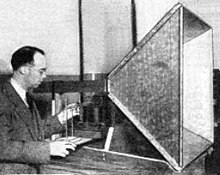
Back Rupor antenası Azerbaijani Antena botzina Catalan Hornantenne Danish Hornstrahler German Antena de bocina Spanish Ruuporantenn Estonian آنتن شیپوری Persian Antenne cornet French Փողային անտենաներ Armenian Antenna a tromba Italian


A horn antenna or microwave horn is an antenna that consists of a flaring metal waveguide shaped like a horn to direct radio waves in a beam. Horns are widely used as antennas at UHF and microwave frequencies, above 300 MHz.[1] They are used as feed antennas (called feed horns) for larger antenna structures such as parabolic antennas, as standard calibration antennas to measure the gain of other antennas, and as directive antennas for such devices as radar guns, automatic door openers, and microwave radiometers.[2] Their advantages are moderate directivity, broad bandwidth, low losses, and simple construction and adjustment.[3]
One of the first horn antennas was constructed in 1897 by Bengali-Indian radio researcher Jagadish Chandra Bose in his pioneering experiments with microwaves.[4][5] The modern horn antenna was invented independently in 1938 by Wilmer Barrow and G. C. Southworth[6][7][8][9] The development of radar in World War II stimulated horn research to design feed horns for radar antennas. The corrugated horn invented by Kay in 1962 has become widely used as a feed horn for microwave antennas such as satellite dishes and radio telescopes.[9]
An advantage of horn antennas is that since they have no resonant elements, they can operate over a wide range of frequencies, a wide bandwidth. The usable bandwidth of horn antennas is typically of the order of 10:1, and can be up to 20:1 (for example allowing it to operate from 1 GHz to 20 GHz).[1] The input impedance is slowly varying over this wide frequency range, allowing low voltage standing wave ratio (VSWR) over the bandwidth.[1] The gain of horn antennas ranges up to 25 dBi, with 10–20 dBi being typical.[1]
- ^ a b c d Bevelacqua, Peter Joseph (2009). "Horn antenna - Intro". Antenna-theory.com website. Retrieved 2010-11-11.
- ^ Poole, Ian. "Horn antenna". Radio-Electronics.com website. Adrio Communications Ltd. Retrieved 2010-11-11.
- ^ Narayan, C. P. (2007). Antennas And Propagation. Technical Publications. p. 159. ISBN 978-81-8431-176-1.
- ^ Rodriguez, Vincente (2010). "A brief history of horns". In Compliance Magazine. Same Page Publishing. Retrieved 2010-11-12.
- ^ Emerson, D. T. (December 1997). "The work of Jagadis Chandra Bose: 100 years of MM-wave research". 1997 IEEE MTT-S International Microwave Symposium Digest. Vol. 45. pp. 2267–2273. Bibcode:1997imsd.conf..553E. CiteSeerX 10.1.1.39.8748. doi:10.1109/MWSYM.1997.602853. ISBN 0-7803-3814-6. S2CID 9039614. Retrieved March 15, 2012.
{{cite book}}:|journal=ignored (help) reprinted in Grigorov, Igor (ed.). "The work of Jagadis Chandra Bose: 100 years of MM-wave research". Antentop. Vol. 2, no. 3. Belgorod, Russia. pp. 87–96. - ^ Southworth, G. C.; King, A. P. (March 1939). "Metal Horns as Directive Receivers of Ultra-Short Waves". Proceedings of the IRE. 27 (2): 95–102. doi:10.1109/JRPROC.1939.229011. S2CID 51632525.
- ^ Barrow, W. L.; Chu, L. J. (February 1939). "Theory of the Electromagnetic Horn". Proceedings of the IRE. 27 (1): 51–64. doi:10.1109/JRPROC.1939.228693. S2CID 51635676. Retrieved October 28, 2015.
- ^ Barrow, Wilmer L, US patent 2467578 Electromagnetic horn, filed: December 10, 1946, granted: April 19, 1949
- ^ a b Olver, A. David (1994). Microwave horns and feeds. USA: IET. pp. 2–4. ISBN 0-85296-809-4.